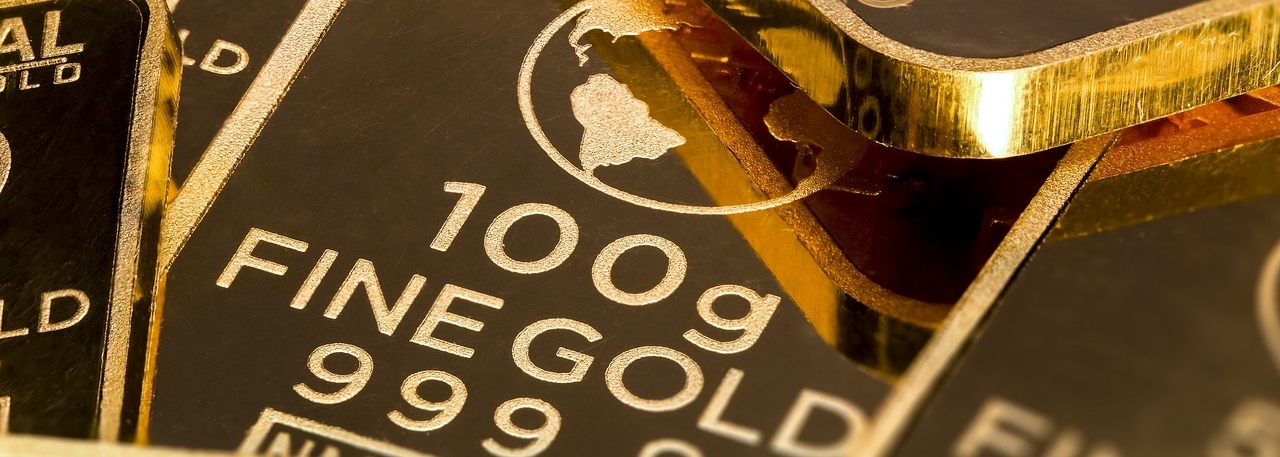A gold ETF, or exchange-traded fund, is a commodity ETF that consists of only one principal asset: gold. Exchange-traded funds act like individual stocks, and they trade on an exchange in the same manner.
However, the fund itself holds gold derivative contracts that are backed by gold. So, if you invest in a gold ETF, you won’t actually own any gold.

Investors use gold ETFs to track and reflect the price of gold. While the assets in the fund are backed by the commodity, the intent is not for an investor to own gold.
A gold ETF gives an investor an opportunity to gain exposure to the performance, or price movements, of gold.
How to Use Gold ETFs
Gold ETFs offer some of the same defensive-asset-class traits as bonds, and many investors use them to hedge against economic and political disruptions, as well as currency debasement1.
Gold tends to rise when the dollar is weak, so if your investment portfolio holds assets that have risk exposure to the dollar’s downside, purchasing a gold ETF may help you hedge that exposure. Conversely, selling a gold ETF can act as a hedge if your portfolio has exposure to the upside.
A gold ETF is a commodity exchange-traded fund that can be used to hedge gold commodity risk or gain exposure to the fluctuations of gold itself. If an investor has increased risk on his portfolio assets when the price of gold rises, owning a gold ETF can help reduce risk in that position.
Or if after ample research, an experienced investor decides to short gold, trading an inverse gold ETF may be a simple way to benefit from falling gold prices.
A good investment
Gold ETFs serve as a good investment vehicle to trade gold, rather than invest in it, since buying and selling physical gold isn’t the most efficient and feasible option. Gold ETFs are significant in that they provide exposure to investors by tracking the price changes of the precious metal, allowing for opportunities to profit without owning the physical asset like gold bars or coins. Thus, when an investor redeems a gold ETF, they do not receive the precious metal, but rather the cash equivalent. Gold ETFs can be accumulated in small amounts and are fairly liquid, meaning they can be easily sold2.
Top rated ETFs of the year
The best gold ETFs for Q1 2020 have returned roughly 8% so far. Over the past 12 months, gold ETFs have returned between 22% and 24%. Among the best performers have been GraniteShares Gold Trust (BAR), Aberdeen Standard Physical Swiss Gold Shares ETF (SGOL), and iShares Gold Trust (IAU). Below, we’ll take a look at each3.
GraniteShares Gold Trust
The GraniteShares Gold Trust (BAR) held 978 physical gold bars at secured vaults in London as of November 2019, or approximately 389,380 troy ounces. BAR is a grantor trust, meaning that it protects investors by limiting how its gold bars can be sold. The fund aims to track the performance of the spot price for gold, less expenses, which are 0.1749%.
Aberdeen Standard Physical Swiss Gold Shares ETF
Like BAR, the Aberdeen Standard Physical Swiss Gold Shares ETF (SGOL) aims to replicate performance of the spot price of gold, less 0.17% for expenses. SGOL is also a grantor trust. As of December 2019, the trust held 321 gold bars at its vault in London (or 128,053 ounces), and 1,657 gold bars at its vault in Switzerland (659,329 ounces).
iShares Gold Trust (IAU)
As one of the largest gold ETFs by assets, IAU is another fund that buys and holds physical gold, with the aim of reflecting the spot price of gold, less expenses of 0.25%. Fund fees help to cover the costs of transporting, storing, and insuring gold bullion. Like BAR and SGOL above, IAU is organized as a grantor trust. IAU stores its gold at vaults in New York, Toronto or London. As of February 2020, it held 30,060 gold bars, or 12.05 million ounces.
Conclusion
Finally, it’s worth repeating that gold ETFs can be extremely volatile. Many investors don’t bother adding commodity exposure to their stock portfolios, as the history of market performance has demonstrated that a mix of stocks, bonds, and cash can let you enjoy solid long-term investment returns that you can tailor to your particular risk tolerance and financial goals. However, if the idea of investing in gold has special appeal to you – or if you like the diversification that an asset with the reputation for safety and security can offer – then it’s worth it to consider whether gold ETFs like the four discussed above can play a role in your overall portfolio4.
Few investors will put all of their money into gold ETFs, but knowing their characteristics can help you decide how large of an investment is right for you.
[1] Kennedy, Mark. “Getting Started With Gold ETFs.” The Balance, 12 March, 2020.
[2] “Gold ETF List.” ETF Trends.
[3] Rieff, Nathan. “Best Gold ETFs for Q1 2020.” Investopia. 18 February, 2020.
[4] Caplinger, Dan. “Gold ETFs: All you need to know.” The Motley Fool. 22 August, 2019.


